In this post I’m going to cover all the basics on pistol sights. We’ll run through the types, uses, and differences. So sit down, crack open a beer, and get your read on.
Pistol Sights
Why the hell did I write an entire post on pistol sights? Because I find my self swapping pistol sights way more that I thought I would. Every time I buy a rifle I know I’ll be putting some sort of sighting system on it. Some bolt guns don’t even come with sights since it’s understood that you’ll mount a scope. Pistol sights are generally an afterthought for most people that buy a pistol, but they shouldn’t be. A set of aftermarket irons can set you back $100. Red dots and scopes creep up around $600 on the high end for pistols. Once you find out what you like you’ll start switching everything over.
If you’re wonder my personal preferences here they are:
- Plinking and USPSA Competition – Flat Black Rear, Fiber Optic Front
- Home Defense/Carry – Three Dot Tritium
- Hunting – I don’t hunt with pistols, but if I did it would be a low power (4x or less) with a duplex reticle
Iron Sights
We’re starting with the basics, and iron sights are as basic as they come. Iron Sights are kind of a catch-all term used to describe a non-electronic, zero magnification set of sights. They’re called iron sights because that’s generally what they are made of. No glass, No batteries, No lasers. Just plain old steel (or plastic if the manufacturer is a cheap shit).
There are several configurations, but 99% of them are some variation of a notch and post sight. A notch and post is exactly what it sounds like. The rear sight has a notch cut into it which allows the shooter to look through to the front sight, which appears as a post. When the sights are properly aligned left/right (windage) and up/down (elevation) the shooter is able to hit what he wants (assuming they don’t flinch, and that the gun is sighted in). Where you hold the front sight on the target is a shooter preference and determined by how you sight it in, we’ll get into it later.
Some of the most common types of notch and post sights are shown here:

As you can see they are all just variation of the same basic design. Styer has an interesting setup on their M9-A1
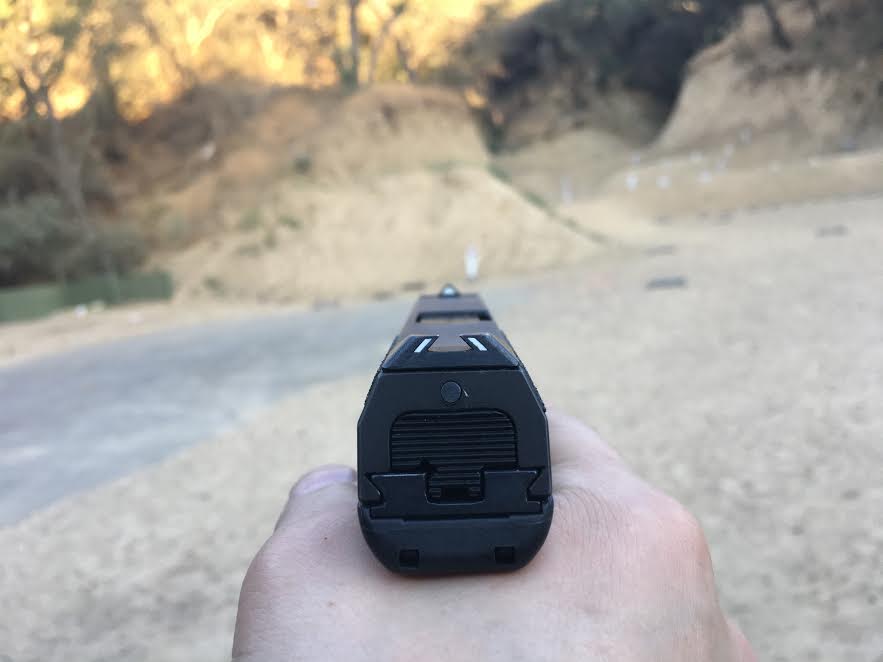
Styer Trapezoid Rear, Triangle Front
Fiber Optic Sights
Fiber optics use a plastic or acrylic fiber optic rod that gathers light via refraction and channels it to each end via reflection. They will always be brighter than the surroundings since they can gather and channel light. However, they do not glow, and cannot emit light when no ambient light is present. They are generally red or green, and less than an inch long. They are super simple, and one of the quickest sight to acquire in daylight. Fiber-optic sights are my go to for front sights on competition pistols. The picture below is the front sight on my CZ 75 Shadow.
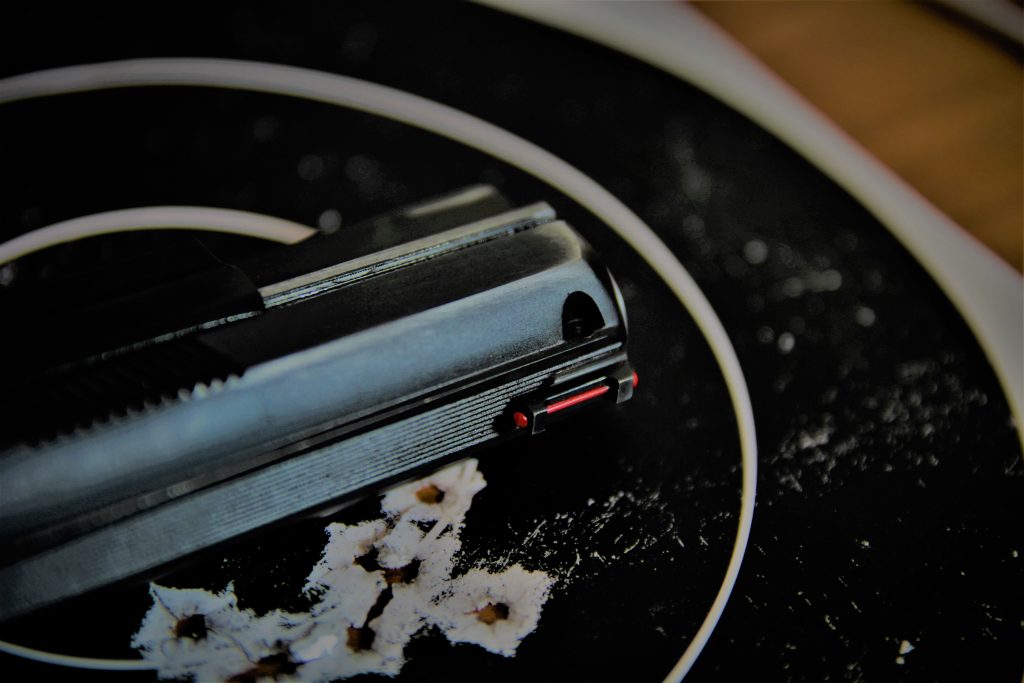
Fiber Optic Front Sight
Night sights
There are really only two types of non-electronic pistol night sights: Phosphorescent and Tritium.
Phosphorescent paint is commonly called glow in the dark paint. It uses phosphors that react to visible light and will glow even after the light source is removed. They do not produce light on their own without first being activated by an external light source. They work if you go from a bright hallway into a dark room, but if the sights have been in the dark for a while you’ll have to “charge” them with light before they will glow. Which in a defensive/tactical/hunting situation is equivalent to blowing an air horn. This is a significant downside compared to tritium sights. They are still super neat. Just more of an art project than a go-to night sight.
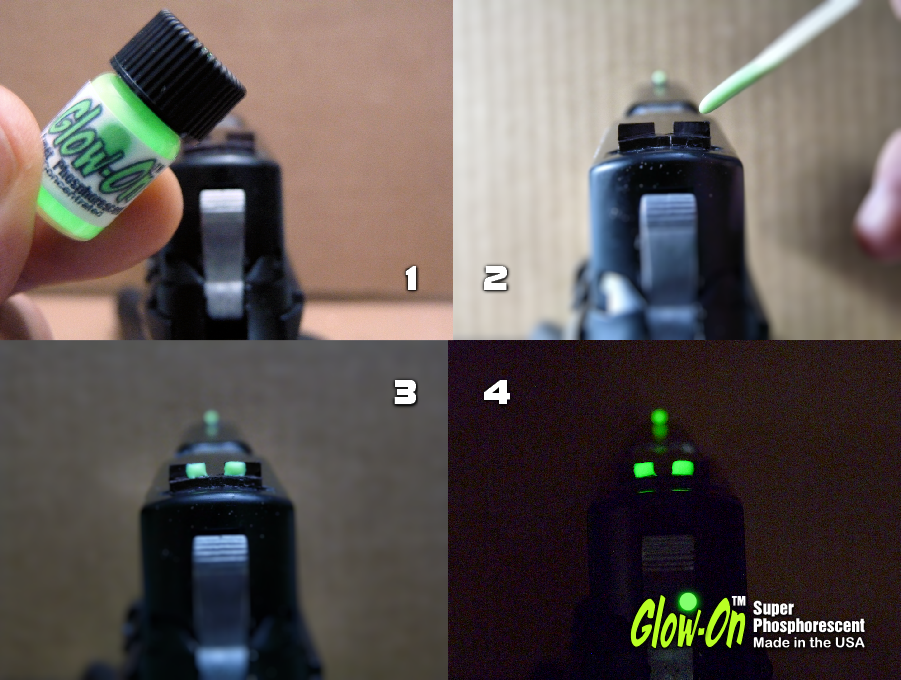
Glow-On Phosphorescent sight paint
Tritium
Unlike phosphorescent sights that may only glow for a matter of minutes or hours. Tritium sights glow in excess of 10 YEARS. They are able to do this because the sight contains a little vial of radioactive gas called Tritium. Yeah you read that right, vials of radioactive gas. It’s like science truck-nuts for your pistol. They glow whether or not any external light source is applied. They glow just as bright whether you just came in from outdoors, or if you pulled it out of a dark safe for the first time in a year. Tritium sights are my go-to for night sights on a pistol, and those little green dots will help you sleep better than an ambien.
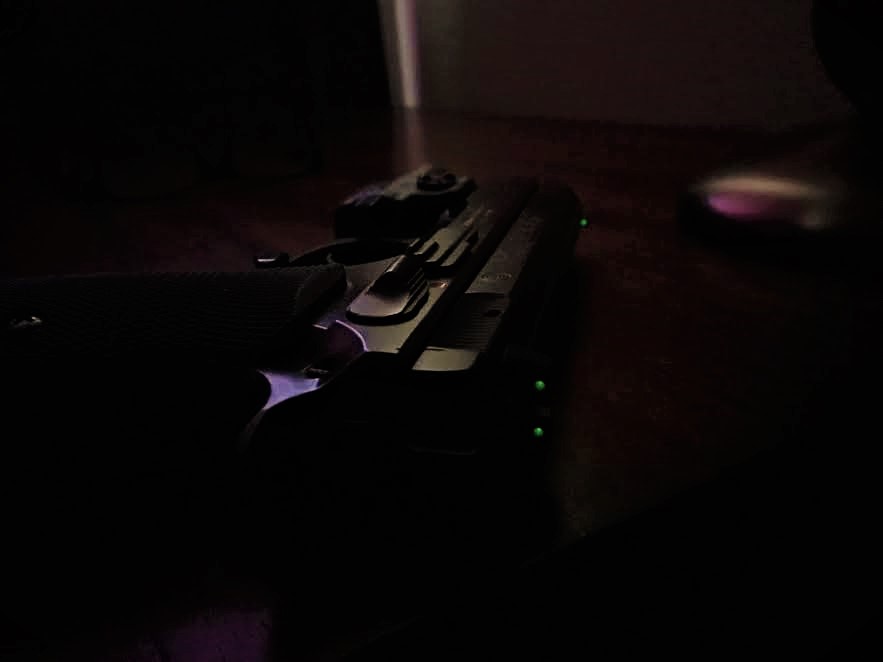
Meprolite Tritium Night Sights
Because you cannot see front or rear sights in the dark, night sights are generally in a 3 dot pattern. 2 dots in the rear and one dot in the front. When the three dots are aligned and evenly spaced you know you’re aiming properly. This is the only time I like a three dot pattern.
Don’t be fooled by cheap imitations. A significant portion of the 3 dot sights out there are not night sights. They are just standard paint mimicking the look of night sights. Think of them as a non-functioning hood scoop for guns.
Sight Focus
One of the major issues with shooting iron sights is trying to switch focus between 3 different focal planes (target, front sight, rear sight). The human eye can only focus at one distance at a time. So unless you are in the circus and can focus your eyes independently, it is impossible to have both the sights and a 25yrd target in focus simultaneously. This is why you hear competition shooters reference target focus, and front sight focus. Because you have to choose what to focus on in different circumstances. Generally target focus up close, and front sight focus for longer shots.
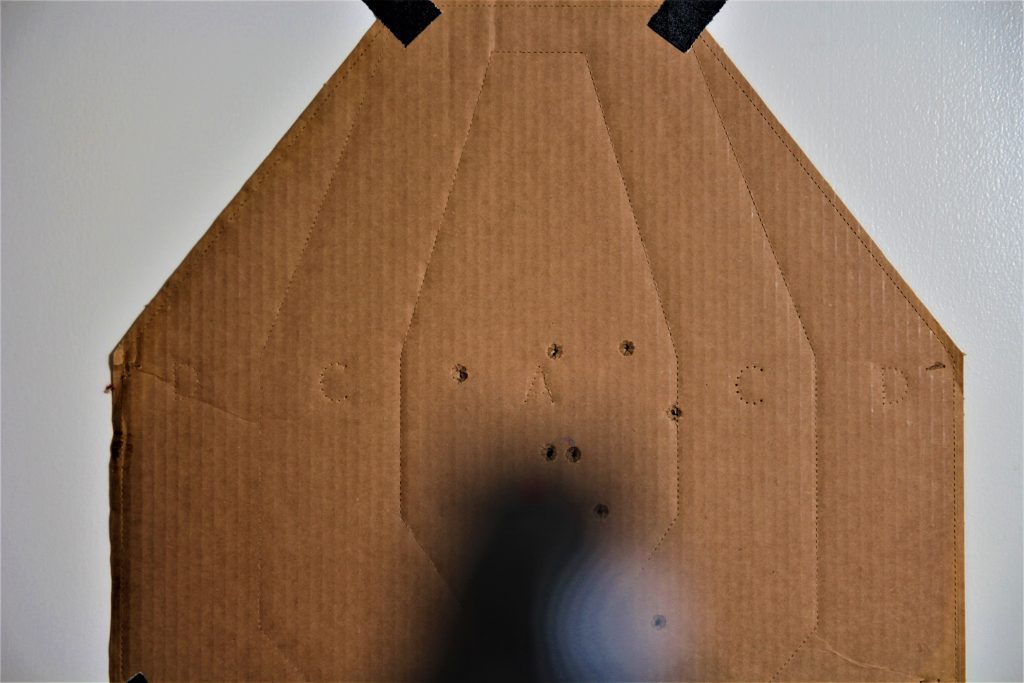
Target Focus
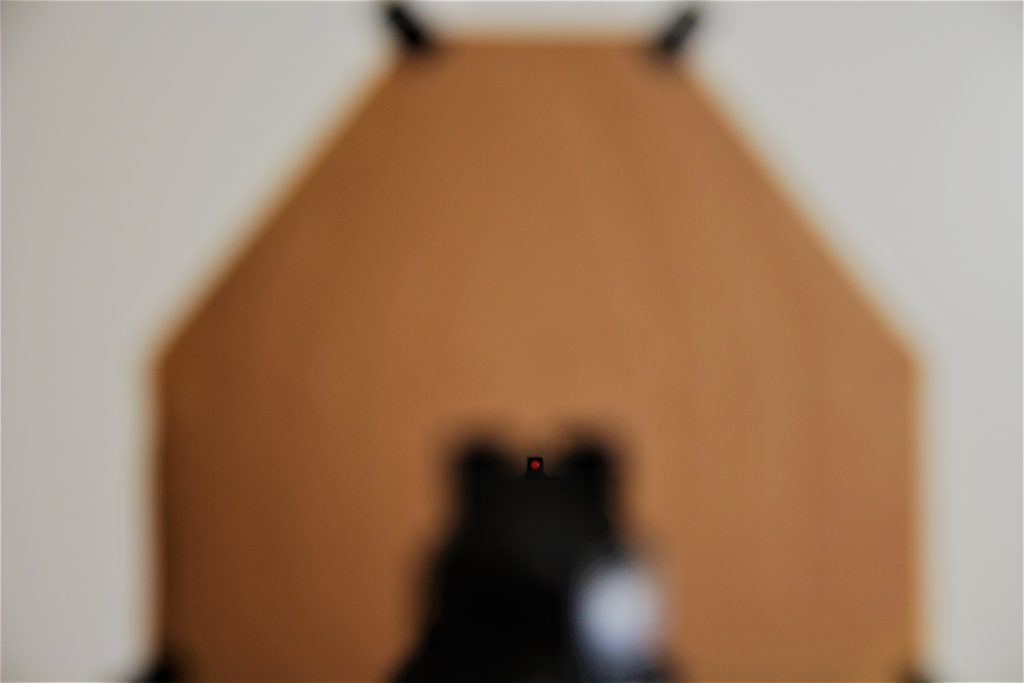
Front Sight Focus
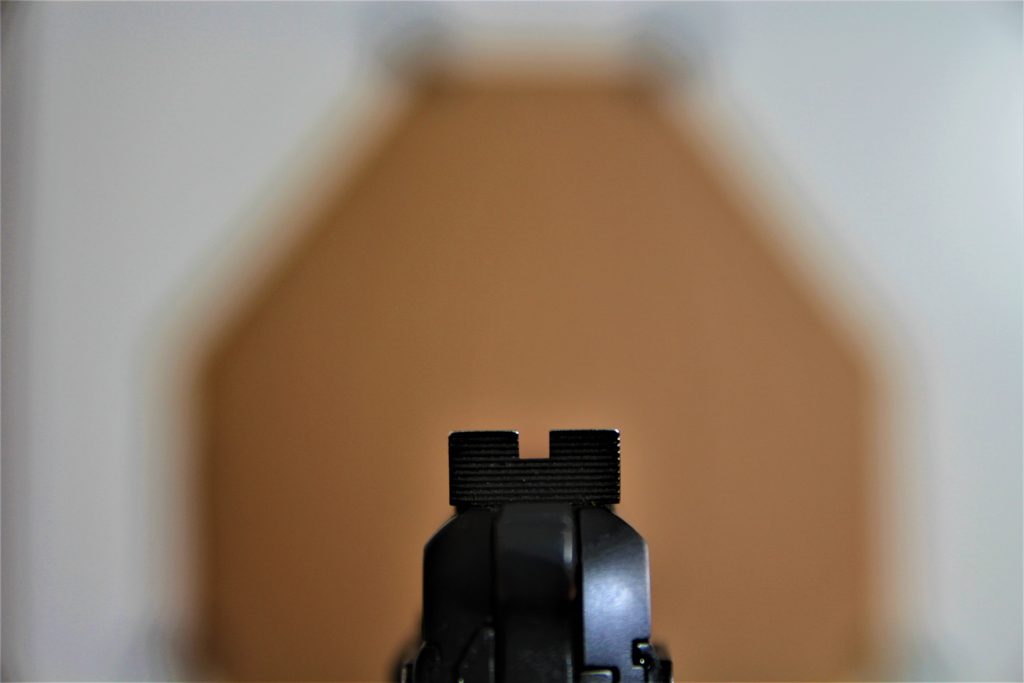
Rear Sight Focus
Optics
This is where optics come in. Optical sights are anything that uses a lense or lenses to superimpose an aiming reticle onto a target while keeping both planes in focus at the same time. This is why you can have the reticle of your scope that is 6 inches in front of your eye in focus at the same time as the deer you’re looking at 300 yards away. Stop and think about that for a second. The reticle is inside the optic right in front of your face, and it’s just as crisp as your target.
Scopes
Scopes do this through a series of lenses and a physical reticle that is generally etched into glass inside the scope. All handgun sights are zero magnification with the exception of scopes. You will generally only see scopes on revolvers and bolt action pistols because mounting a scope to a slide is a bad idea for a bunch of reasons. Also, yeah I said bolt action pistol. If you’re interested in seeing a hideous space blaster just google Remington XP100.
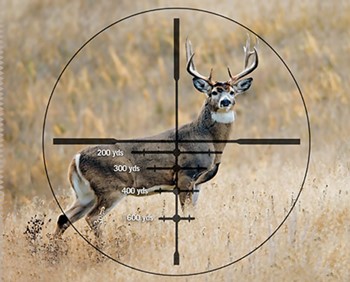
Red Dot Sights
Red dot sights are also optical sights. They superimpose an aiming reticle on a target with reflected led light on a curved lense. There are several types of red dots, but the most popular style for pistols is a reflex sight. This is because they are extremely compact, and can generally be slide-mounted. I have several Burris Fastfire reflex sights (Fastfire III) on rifles because they work great and I’m too cheap to buy a Trijicon RMR. Fun fact: RMR stands for “ruggedized miniature reflex”. You can get small reflex sighs to fit on a concealed rig, and USPSA even has a carry optics division. I don’t have any pistol reflex sight because I want to save something other than Viagra for when I’m old.
Laser sights
Laser sights the easiest to explain. It’s basically a laser pointer mounted on your pistol. When a button or pressure pad is pressed the laser is activated. Basically, you look past the sights and focus on the target. When the laser is where you want it you squeeze the trigger. Obviously, this only works well in certain circumstances. In bright light or at long distance the laser is difficult to see. Having said that they are almost always used in conjunction with another type of sighting system.
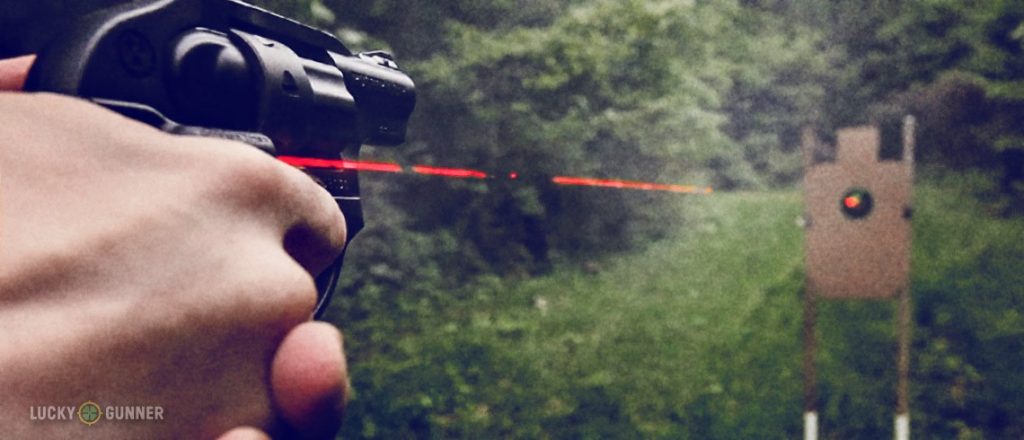
Awesome laser shot by the guys at Lucky Gunner
Sighting in
Sighting in iron sights on pistols can be difficult compared to iron sights on rifles. This is because in most cases pistols to not have conventionally adjustable sights. More often than not they are a front post of a fixed height and a rear sight of a fixed height. The most common way to adjust for widage is by drifting the rear sight left or right in the dovetail. This can be done with a brass punch and mallet, or a specialized tool called a sight pusher.
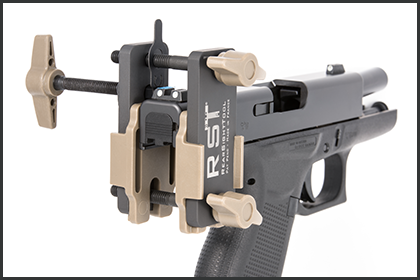
RST Sight Pusher
Some of the reasons that adjustable sights are standard on rifles and not pistols is because of the average distances that they are shot at. If you’re 1/2” left at 12 yards and your longest shot is 12 yards that’s not a big deal. If you’re ½” left at 12 and your longest shot is 100 yards that’s a different story. A quick rule of thumb is to drift the rear sight in the direction yo want the bullet to go, the front sight is the opposite.
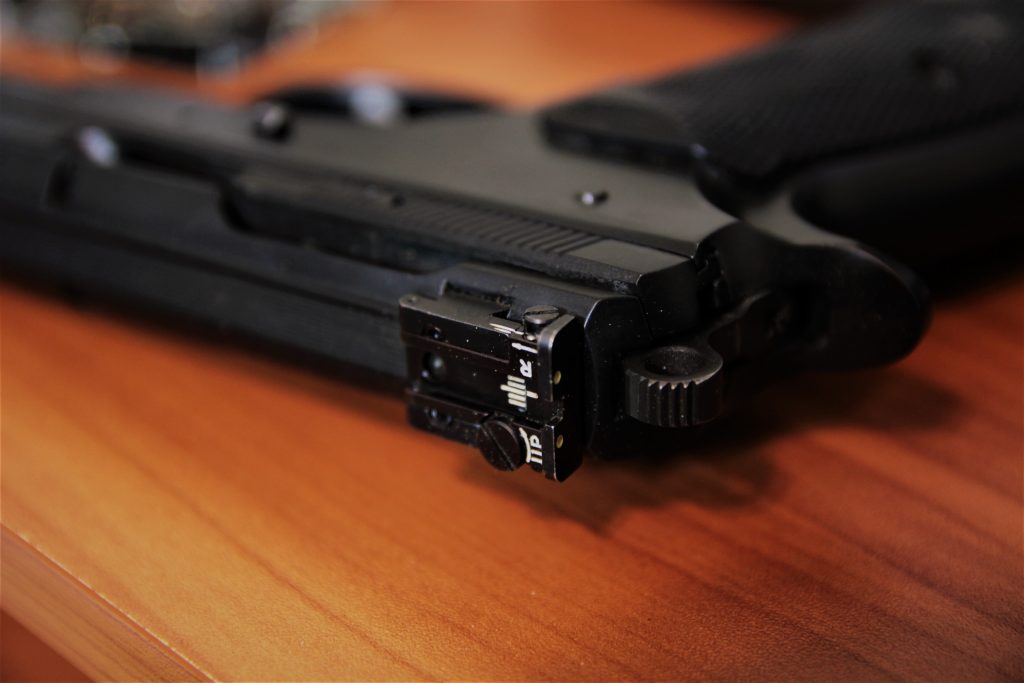
Adjustable Target Sights
Its also important to note that the abuse endured by a slide mounted sight on a semi auto pistol is far more than that seen by most rifles. A poorly designed sight on a the slide of a 10mm will not last very long.
Sight Picture
An extremely common question is “where should I be aiming” or “what should my sight picture look like?” That’s a good question. If you have the ability to adjust your sights then you have full control over the relationship between Point of Aim (POA) and Point of Impact (POI). POA is where you are aiming, and POI is where the bullets are landing. Several factors affect this relationship: distance to target, wind drift, different types of ammo…etc. For the purposes of this article we’re just talking about where you set your sights. Here are the most common:
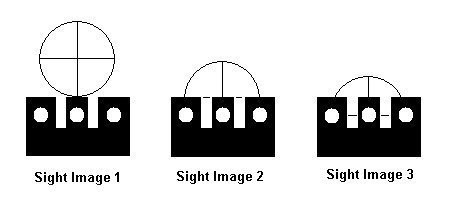
#1 is generally referred to as 6-o’clock hold, #2 is a POA=POI hold for most sight configurations, #3 is POA=POI that some people use for dot front sights.
Personally, I use #2. It allows you to see enough of the target, and takes the guess work out of where your shot is going to land.
#1 is completely dependent on the size of the target. For example: if your target was a 12” circle and you were dead on, then you moved to a 6” target with the same hold your bullet would barley be touching the top of the target.
#3 obscures too much of the target for me for anything past about 12 yards.
Sight radius
Sight radius is the distance between the front and rear sight. The longer the distance the easier it will be for your eyes to determine subtle movements in sight alignment. A longer sight radius doesn’t make your firearm more accurate, but it may make it easier for you to aim.
Also, it should go without saying that your maximum sight radius is limited to the overall length of your firearm. There are a ton of analogies I could use to describe sight radius, but the simplest is comparing a rifle to a snub nose revolver. Both are completely capable of hitting a watermelon at 100 yards. But it is significantly easier to aim the rifle because it has a longer sight radius. Also, because the front sight is further away from the rear sight it appears smaller. A pistol front sight could be the equivalent of 4 feet wide at 100 yards, while a rifle’s may only be 8” wide.
To sum it up:
- Decide what you’re using your pistol for (pinking, hunting, defense)
- Do you need to be able to shoot when it’s dark out?
- Generally the simpler the sight the more robust it will be.
- Try before you buy if possible.
